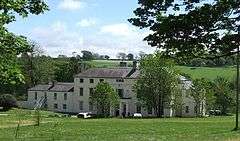Sealyham House
| Sealyham Mansion | |
|---|---|
 Sealyham Mansion | |
 | |
| General information | |
| Location | Near Wolfscastle, Pembrokeshire |
| Country | Wales |
| Coordinates | 51°54′48″N 4°57′33″W / 51.91333°N 4.95917°WCoordinates: 51°54′48″N 4°57′33″W / 51.91333°N 4.95917°W |

Sealyham Mansion, overlooking the little River Sealy,[1] is a Georgian country house in Pembrokeshire, Wales, near Wolfscastle and to the southeast of Letterston. Known for the creation of the Sealyham Terrier there in the 1800s, the house served as a sanatorium and medical facility from 1923 to 1964. Since 1986 it has been a children's activity centre.[2]
History
King Edward III granted some land at Sealyham in Pembrokeshire (Wales) to Thomas Tucker in the fourteenth century. Tucker was a captain in the King's army about 1356.[3] From that time “The Tuckers of Sealyham” remained identified with the manor until 1777.[4] Though Tucker signifies a fuller of cloth,[5] there is a tradition that the first Tucker had accompanied William the Conqueror in 1066 to England.[6] Tucker married Ursula del Holme and they built a house at this Sealyham property, which is some 200 miles (320 km) southwest of Liverpool. The house was rebuilt in the mid-18th century. In 1777 the heiress to the property, Mary Tucker, married John-Owen Edwardes.[7] Their heir was William Edwardes (d. 1825), who was succeed by William Edwardes-Tucker.[8] Captain John Edwardes was a descendant of this couple. In 1840, Tucker-Edwardes was married to Anna Jane Jones of Letterston (Wales) and their only son was John Tucker-Edwardes (1845) who married Hester Phillips. He died in 1891 (at 82 years of age) and his father also died in the same year. As they had no offspring Sealyham House became the property of John Owen's brother, Owen, who also died two years later in 1893; his son Charles Gustaves Whittaker Edwardes who inherited the property died in 1902 without any children.[6]
John Edwardes bred the Sealyham Terrier rare Welsh breed dog. It turned out the last of the descendant family members to live at the Sealyham Mansion was Mrs Catherine Octavia Edwards. She married Victor James Higgon. In 1905, they moved to Treffgarne Hall. Around 1910, portions of the land were sold to the Pembrokeshire County Council.[9]
In 1920, Sealyham Mansion and its immediate associated land were sold to the King Edward VII Welsh National Memorial Association. The estate was converted into a tuberculosis hospital with 30 beds.[10] It continued to function as a tuberculosis hospital to 1954. In 1955, it was re-purposed for elderly patients, but was permanently closed as a medical facility in 1964.[9] In 1970, the Sealyham Mansion was sold to Nancy Ellen Perkins. She converted it into an apartment building as rentals.[9] In 1980, it was sold again to an investment firm that used it for an outdoor activities center.[9] It was resold in 1986 to the Sealyham Activity Centre for young people as an educational facility.[9]
Sealyham Terrier
The Tucker-Edwardes family of the 1800s were one of the leading landowners of Pembrokeshire.[11] Headed by Captain John Edwardes (1808-91), the family had the time and the means to breed dogs, which was almost a prerogative of people of noble families or military background.[6] The Welsh Corgi, Fox Terrier (Wire), and the now extinct English White Terrier all played a part in the make up of the Sealyham,[12] although Edwardes did not keep records.[13] After Edwardes' death in 1891, other breeders began to work with Sealyhams,[13] including Fred Lewis who promoted the breed.[14] According to the Kennel Club Stud Book of 2009 there were only 47 dogs of Tucker-Edwardes' breed, making it an endangered breed.[6]
References
- ↑ Richard Fenton, A Historical Tour through Pembrokeshire, 1811:339.
- ↑ "Sealyham Activity Centre". Retrieved 19 February 2013.
- ↑ "About Sealyhams". 2012. Retrieved 19 February 2013.
- ↑ Their monument in the church at St. Dogwells (Llan ty Dewi) is noted in Fenton 1811:339.
- ↑ John Rowlands, Sheila Rowlands, The Surnames of Wales: For Family Historians and Others, 1996:156.
- 1 2 3 4 "Masterminds" (pdf). Capt. John Owen Tucker-Edwardes and the Sealyham Terrier. Retrieved 22 February 2013. line feed character in
|work=at position 40 (help) - ↑ Elizabeth Tucker married John Owen Edwardes, according to James Allen (Dean of St. David's), Notes on the Sheriffs of Pembrokeshire, 1541-1899, 1900, s.v. "1763 John Tucker", "1829 John Owen Edwardes".
- ↑ Burke, John (1835). A Genealogical and Heraldic History of the Commoners of Great Britain and Ireland, Enjoying Territorial Possessions Or High Official Rank: But Uninvested with Heritable Honours (Public domain ed.). Henry Colburn. pp. 315–. Retrieved 20 February 2013.
- 1 2 3 4 5 "Our Guide to your Week at Sealyham Activity Centre, p. 3" (PDF). 2012. Retrieved 19 February 2013.
- ↑ "Papers by Command, Volume 13 by Great Britain. Parliament. House of Commons". 1921. p. 178. Retrieved 19 February 2013.
- ↑ The family title, held by a cousin, is Baron Kensington.
- ↑ Hough, Andrew (26 October 2011). "Campaign launched to save Sealyham terriers 'from extinction'". The Daily Telegraph. Retrieved 26 December 2011.
- 1 2 Waugh, Tessa (26 October 2011). "Country Life says: Save our Sealyhams". Country Life. Retrieved 26 December 2011.
- ↑ "Sealyham Terrier". The Kennel Club. Retrieved 7 January 2012.